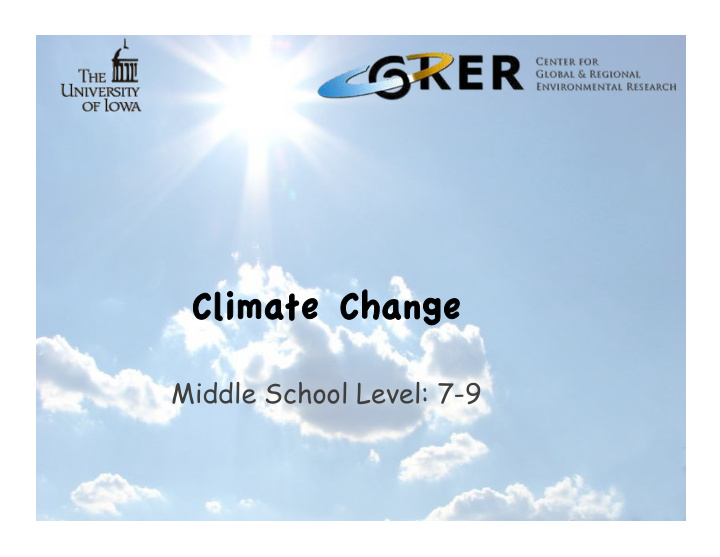



Climate Change Climate Change Middle School Level: 7-9
Overview of content Overview of content 1. Weather vs. Climate: what’s the difference? 2. What do we know about climate change? 3. Earth’s climate history 4. Human influence on climate 5. The future 6. Renewable energy 7. Discussion Courtesy of the Center for Global and Regional Environmental Research
1. WEATHER VS. CLIMATE 1. WEATHER VS. CLIMATE What’s the difference? Courtesy of the Center for Global and Regional Environmental Research
What is weather? What is weather? Weather is what we experience every day NWS: Iowa City, Iowa Courtesy of the Center for Global and Regional Environmental Research
What is climate? What is climate? What makes climate different from weather? How would you describe the climate for… • A desert? • A rainforest? Courtesy of the Center for Global and Regional Environmental Research
Try this: Try this: Courtesy of the Center for Global and Regional Environmental Research
Summary Summary Weather is what we experience day-to-day • It can vary a lot Climate is a long-term average • It represents what is typical for a region Climate change is a big deal! Courtesy of the Center for Global and Regional Environmental Research
2. WHAT DO WE KNOW ABOUT 2. WHAT DO WE KNOW ABOUT CLIMATE CHANGE? CLIMATE CHANGE? Courtesy of the Center for Global and Regional Environmental Research
Who is the climate change Who is the climate change authority? authority? Intergovernmental Panel on Climate Change (or, IPCC for short) Combines all scientific information on climate change Courtesy of the Center for Global and Regional Environmental Research
Where does data come from? Where does data come from? Observing weather from weather stations • Only goes back about 100 years Courtesy of the Center for Global and Regional Environmental Research
Courtesy of the Center for Global and Regional Environmental Research
Earth’s climate history Earth’s climate history Ice cores tell us Earth’s temperature history Courtesy of the Center for Global and Regional Environmental Research
How does CO How does CO 2 change Earth’s change Earth’s climate? climate? Image from Ruddiman 2000. Earth’s Climate: Courtesy of the Center for Global and Past and Future. W.H. Freeman and Co. Regional Environmental Research
Summary Summary Temperature has changed naturally over Earth’s history Ice volume has changed naturally over Earth’s history Courtesy of the Center for Global and Regional Environmental Research
Courtesy of the Center for Global and Regional Environmental Research
CO CO 2 is increasing in our is increasing in our atmosphere atmosphere Courtesy of the Center for Global and Regional Environmental Research
The “Hockey Stick” The “Hockey Stick” Courtesy of the Center for Global and Regional Environmental Research
CO 2 is not the only Green House Gas • Methane • Water vapor Courtesy of the Center for Global and Regional Environmental Research
Effects of our changing Effects of our changing climate climate YouTube: Arctic methane vent YouTube: Arctic sea ice melt 2007 YouTube: First year sea ice Courtesy of the Center for Global and Regional Environmental Research
Models predict more change Models predict more change Models show us what will likely happen if we: • Don’t change anything • Change a little • Change a lot • Stop releasing all Courtesy of the Center for Global and Regional Environmental Research GHGs
Our changing oceans Our changing oceans Images from Roger Braithwaite. Sea ice is melting So is Antarctica, and Greenland Courtesy of the Center for Global and Regional Environmental Research
Sea level rise with melting ice Sea level rise with melting ice caps caps Courtesy of the Center for Global and Regional Environmental Research
Summary Summary The future of our climate depends on how we react now. Melting polar ice will have an impact on society and the economy unless we do something. Courtesy of the Center for Global and Regional Environmental Research
6. RENEWABLE ENERGY 6. RENEWABLE ENERGY Courtesy of the Center for Global and Regional Environmental Research
Solar panels Solar panels Harnesses the energy from the sun Technology of solar panels continue to improve Equipped with battery storage • Have electricity for night time and cloudy days Courtesy of the Center for Global and Regional Environmental Research
Wind power Wind power Courtesy of the Center for Global and Regional Environmental Research
Biodiesel and Ethanol Biodiesel and Ethanol Ethanol from: • Corn, sugar cane, sugar beets, potatoes Biodiesel from: • Waste cooking oil, soybeans, canola Cars are already able to run on ethanol and biodiesel. Courtesy of the Center for Global and Regional Environmental Research
7. DISCUSSION 7. DISCUSSION Courtesy of the Center for Global and Regional Environmental Research
For more information… For more information… IPCC NOAA NWS Courtesy of the Center for Global and Regional Environmental Research
Recommend
More recommend